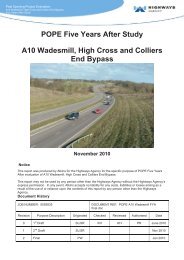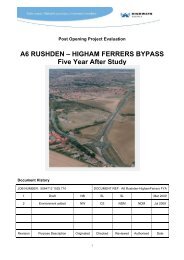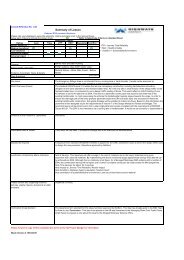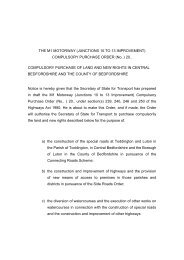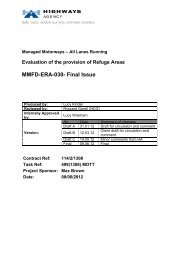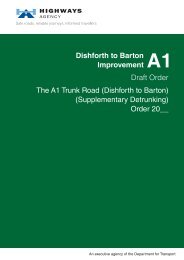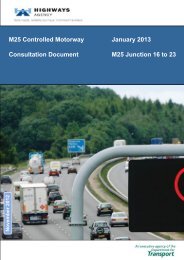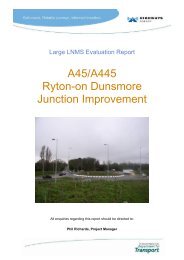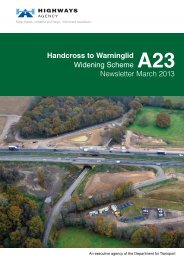A1(T) Elkesley Junction Improvements - Highways Agency
A1(T) Elkesley Junction Improvements - Highways Agency
A1(T) Elkesley Junction Improvements - Highways Agency
You also want an ePaper? Increase the reach of your titles
YUMPU automatically turns print PDFs into web optimized ePapers that Google loves.
associated with Jockey Lane forms an intermediate visual horizon line to views fromthe south and east.To the immediate south of the existing <strong>A1</strong>(T) corridor <strong>Elkesley</strong> village lies in closeproximity. Its northernmost fringes are visually exposed to the carriageway as itbypasses the village and rises westwards, although much of the village is obscuredfrom view by built form. The numerous field boundary hedges, hedgerow trees andthe more varied landform bounding the River Poulter further contain the visualenvelope to the south.Beyond <strong>Elkesley</strong> and the industrial estate to the east, landform descends toward thenarrow River Poulter valley and the B6387 road crossing. This area lies beyond theZVI of the proposed junction, there being a distinction between the setting of thislocal landscape and that of the proposed junction area.Lighting (in relation to both Landscape Character and Visual Context)The influence of the <strong>A1</strong>(T) corridor, in terms of both landscape character and visualcontext extends beyond daylight hours and extends to hours of darkness. Thephysical presence of lighting columns and associated constructions raises the visualprofile of the route corridor by approx 10 m above the carriageway, increasing thevisual envelope of the transport corridor and placing it as a feature or component ofthe wider landscape. Ambient light levels during hours of darkness are noticeable,particularly in a rural landscape where the presence of a major route corridor can bemore apparent at night-time when other landscape interventions are less visible.On the main carriageway of the <strong>A1</strong>(T), the existing lighting generally consists of 10metre high twin armed columns along the central reserve. Where the central reservewidens, 2 by 10 m single armed columns are utilised. At various points the columnsare verge mounted in an opposite configuration. The lanterns are mounted onbrackets estimated to be 1.0 to 1.75 m in length, and support high pressure sodium(SON/T) lamps that are assumed to be 250 watts. In addition, single-armed columnsare used on the slip roads and in areas where conflict areas exist. This provides anadequate and safe level of light for drivers at junctions.The existing Nottinghamshire CC assets that are affected by the proposed schemeare situated along the High Street, Coalpit Lane and Twyford Lane within the villageof <strong>Elkesley</strong>. Existing columns are 5 metres in height with 55W low pressure sodium(SOX) lamps, each lantern having a Photo Electric Control Unit (PECU) fitted.All of the lighting installations would have met lighting standards at the time ofinstallation but do not meet current lighting standards. The presence of the <strong>A1</strong>(T)corridor places a major source of illumination within the local landscape and inproximity to <strong>Elkesley</strong> Village.7.4 Potential ImpactsPotential Impacts on Landscape CharacterThe main predicted impacts on landscape character as highlighted within the Stage 2EAR are as follows.• The introduction of a new over bridge structure with a roundaboutconstruction to the north of the existing carriageway.47



